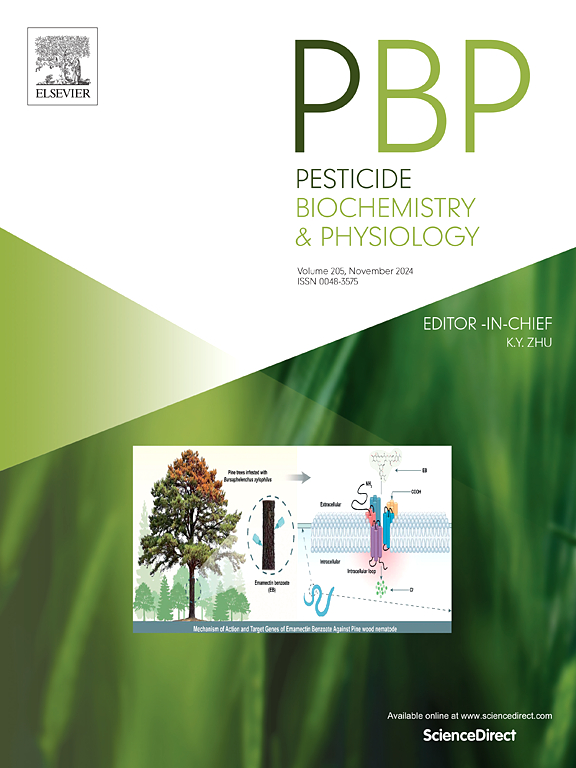Genistein: A promising botanical fungicide candidate for enhancing tomato yield and quality by controlling Alternaria solani
IF 4
1区 农林科学
Q2 BIOCHEMISTRY & MOLECULAR BIOLOGY
引用次数: 0
Abstract
The overreliance on traditional chemical fungicides, combined with the emergence of resistance, poses significant challenges for food safety. Early blight, caused by the fungal pathogen Alternaria solani (A. solani), is among the most significant contributors to pre- and postharvest yield losses in tomato cultivation. To address this challenge, through evaluation of the antifungal activity of 52 commercially available natural products against A. solani, we revealed for the first time that the naturally occurring compound genistein exhibited potent fungicidal activity against A. solani, with an EC50 value of 6.53 μg/mL, surpassing that of chlorothalonil (EC50 = 8.35 μg/mL). In vivo assays demonstrated that genistein exhibited strong protective (48.1 %) and therapeutic (42.5 %) efficacy, effectively safeguarding tomatoes from fungal infection. Mechanistic investigations, including transcriptomic analysis, scanning electron microscopy, fluorescence imaging, and measurements of malondialdehyde and ATP levels, collectively indicated that genistein disrupted energy metabolism, leading to reactive oxygen species (ROS) accumulation. This oxidative stress cascade triggered both apoptotic-like responses and membrane lipid peroxidation, ultimately inhibiting the growth of A. solani. Interestingly, genistein showed enhanced anti-A. solani activity when used in combination with either chlorothalonil or tebuconazole. Additionally, genistein displayed low phytotoxicity and favorable drug-likeness properties. Taken together, these findings elucidate the mechanisms underlying genistein's antifungal activity against A. solani, underscoring its promise as a natural antifungal agent for enhancing food safety and improving tomato yield and quality. Furthermore, this study provides valuable insights for the rational design of flavonoid-based antifungal agents.

染料木素:一种很有前途的植物性杀菌剂,可通过控制茄疫病提高番茄产量和品质
对传统化学杀菌剂的过度依赖,加上耐药性的出现,对食品安全构成了重大挑战。番茄早疫病是番茄种植中造成采前和采后产量损失的最主要原因之一,是由真菌病原菌番茄赤霉(a.s ornaria solani)引起的。为了解决这一挑战,通过对52种市售天然产物对茄蚜的抑菌活性进行评价,我们首次发现天然化合物染料木素对茄蚜具有较强的抑菌活性,其EC50值为6.53 μg/mL,超过了百菌清(EC50 = 8.35 μg/mL)。体内实验表明染料木素具有较强的保护作用(48.1%)和治疗作用(42.5%),能有效保护番茄免受真菌感染。机制研究,包括转录组学分析、扫描电子显微镜、荧光成像以及丙二醛和ATP水平的测量,共同表明染料木素破坏了能量代谢,导致活性氧(ROS)积累。这种氧化应激级联反应触发了细胞凋亡样反应和膜脂过氧化反应,最终抑制了茄茄的生长。有趣的是,染料木黄酮显示出增强的抗a。与百菌清或替布康唑联合使用时索拉尼活性。此外,染料木黄酮显示出低植物毒性和良好的药物相似特性。综上所述,这些发现阐明了染料木黄酮抗茄茄病真菌活性的机制,强调了其作为一种天然抗真菌剂在提高食品安全、提高番茄产量和质量方面的前景。此外,该研究为合理设计类黄酮类抗真菌药物提供了有价值的见解。
本文章由计算机程序翻译,如有差异,请以英文原文为准。
求助全文
约1分钟内获得全文
求助全文
来源期刊
CiteScore
7.00
自引率
8.50%
发文量
238
审稿时长
4.2 months
期刊介绍:
Pesticide Biochemistry and Physiology publishes original scientific articles pertaining to the mode of action of plant protection agents such as insecticides, fungicides, herbicides, and similar compounds, including nonlethal pest control agents, biosynthesis of pheromones, hormones, and plant resistance agents. Manuscripts may include a biochemical, physiological, or molecular study for an understanding of comparative toxicology or selective toxicity of both target and nontarget organisms. Particular interest will be given to studies on the molecular biology of pest control, toxicology, and pesticide resistance.
Research Areas Emphasized Include the Biochemistry and Physiology of:
• Comparative toxicity
• Mode of action
• Pathophysiology
• Plant growth regulators
• Resistance
• Other effects of pesticides on both parasites and hosts.

 求助内容:
求助内容: 应助结果提醒方式:
应助结果提醒方式:


